Sustainable Supply Chain Management and Circular Economy
VerifiedAdded on 2020/10/05
|15
|4264
|61
AI Summary
This assignment delves into the concept of sustainable supply chain management and its role in transitioning towards a circular economy. It presents a comprehensive review of existing literature on the topic, highlighting key findings and applications from various industries and sectors. The document also explores the impact of green manufacturing practices on organizational performance in an Indian context. It includes a range of references from reputable sources, including academic journals and research papers.
Contribute Materials
Your contribution can guide someone’s learning journey. Share your
documents today.
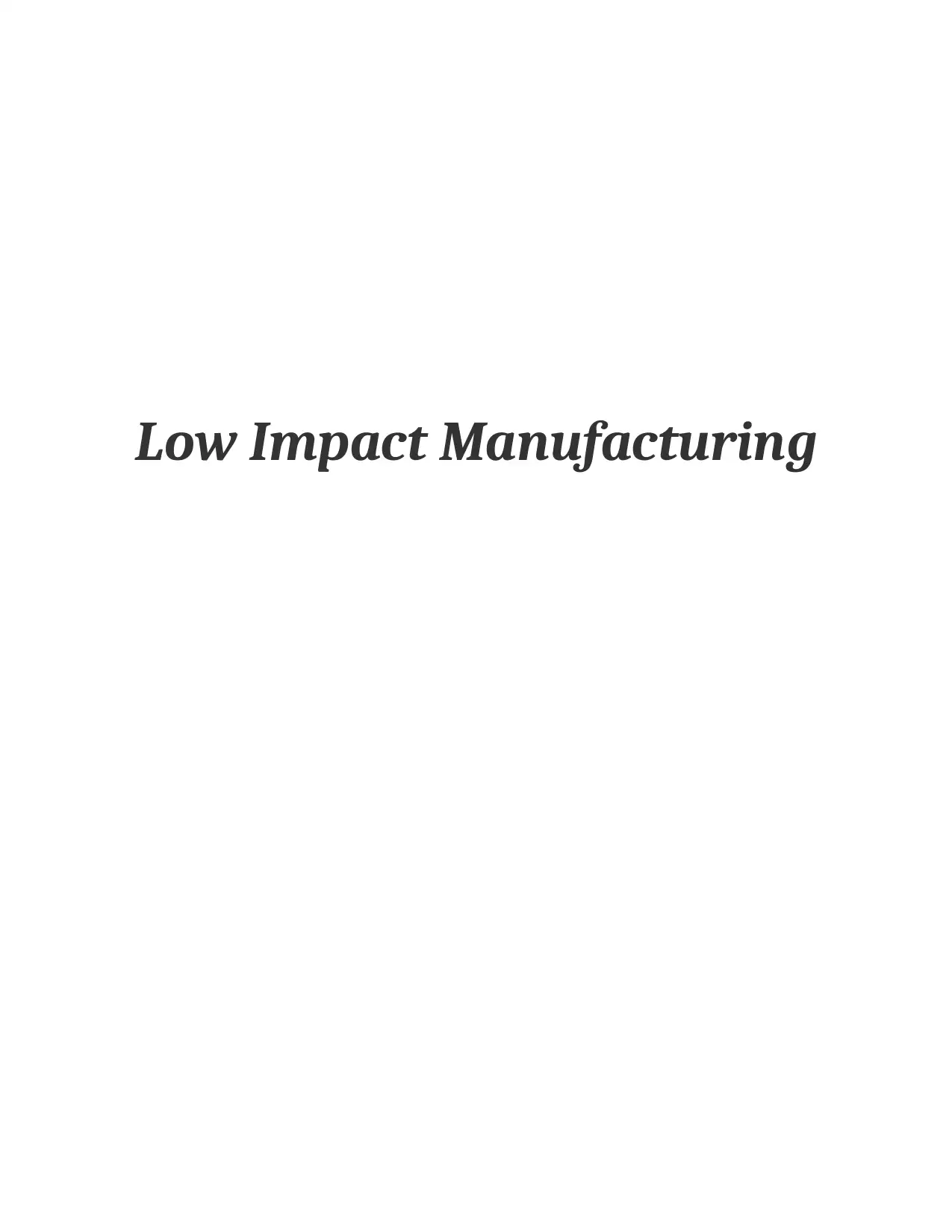
Low Impact Manufacturing
Secure Best Marks with AI Grader
Need help grading? Try our AI Grader for instant feedback on your assignments.
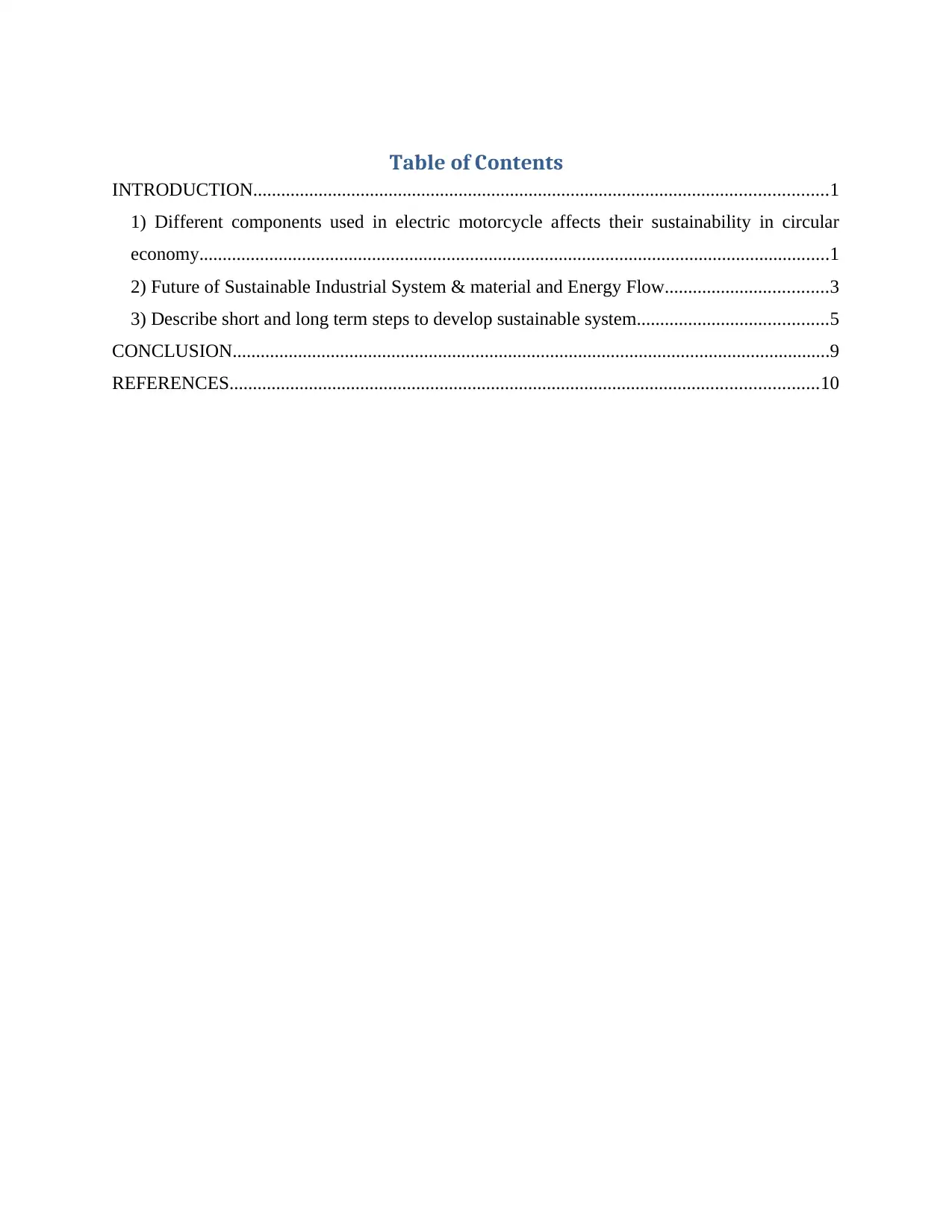
Table of Contents
INTRODUCTION...........................................................................................................................1
1) Different components used in electric motorcycle affects their sustainability in circular
economy.......................................................................................................................................1
2) Future of Sustainable Industrial System & material and Energy Flow...................................3
3) Describe short and long term steps to develop sustainable system.........................................5
CONCLUSION................................................................................................................................9
REFERENCES..............................................................................................................................10
INTRODUCTION...........................................................................................................................1
1) Different components used in electric motorcycle affects their sustainability in circular
economy.......................................................................................................................................1
2) Future of Sustainable Industrial System & material and Energy Flow...................................3
3) Describe short and long term steps to develop sustainable system.........................................5
CONCLUSION................................................................................................................................9
REFERENCES..............................................................................................................................10
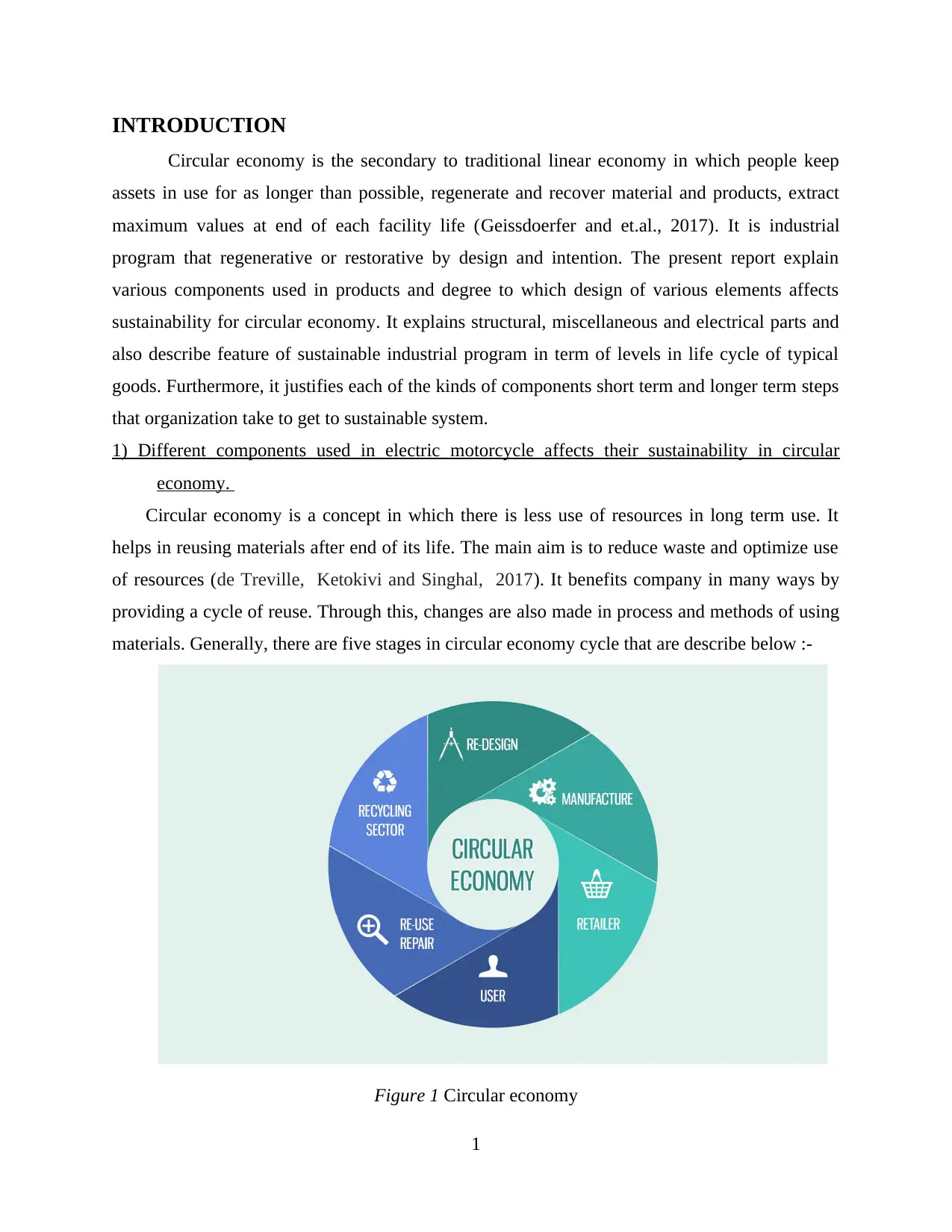
INTRODUCTION
Circular economy is the secondary to traditional linear economy in which people keep
assets in use for as longer than possible, regenerate and recover material and products, extract
maximum values at end of each facility life (Geissdoerfer and et.al., 2017). It is industrial
program that regenerative or restorative by design and intention. The present report explain
various components used in products and degree to which design of various elements affects
sustainability for circular economy. It explains structural, miscellaneous and electrical parts and
also describe feature of sustainable industrial program in term of levels in life cycle of typical
goods. Furthermore, it justifies each of the kinds of components short term and longer term steps
that organization take to get to sustainable system.
1) Different components used in electric motorcycle affects their sustainability in circular
economy.
Circular economy is a concept in which there is less use of resources in long term use. It
helps in reusing materials after end of its life. The main aim is to reduce waste and optimize use
of resources (de Treville, Ketokivi and Singhal, 2017). It benefits company in many ways by
providing a cycle of reuse. Through this, changes are also made in process and methods of using
materials. Generally, there are five stages in circular economy cycle that are describe below :-
Figure 1 Circular economy
1
Circular economy is the secondary to traditional linear economy in which people keep
assets in use for as longer than possible, regenerate and recover material and products, extract
maximum values at end of each facility life (Geissdoerfer and et.al., 2017). It is industrial
program that regenerative or restorative by design and intention. The present report explain
various components used in products and degree to which design of various elements affects
sustainability for circular economy. It explains structural, miscellaneous and electrical parts and
also describe feature of sustainable industrial program in term of levels in life cycle of typical
goods. Furthermore, it justifies each of the kinds of components short term and longer term steps
that organization take to get to sustainable system.
1) Different components used in electric motorcycle affects their sustainability in circular
economy.
Circular economy is a concept in which there is less use of resources in long term use. It
helps in reusing materials after end of its life. The main aim is to reduce waste and optimize use
of resources (de Treville, Ketokivi and Singhal, 2017). It benefits company in many ways by
providing a cycle of reuse. Through this, changes are also made in process and methods of using
materials. Generally, there are five stages in circular economy cycle that are describe below :-
Figure 1 Circular economy
1
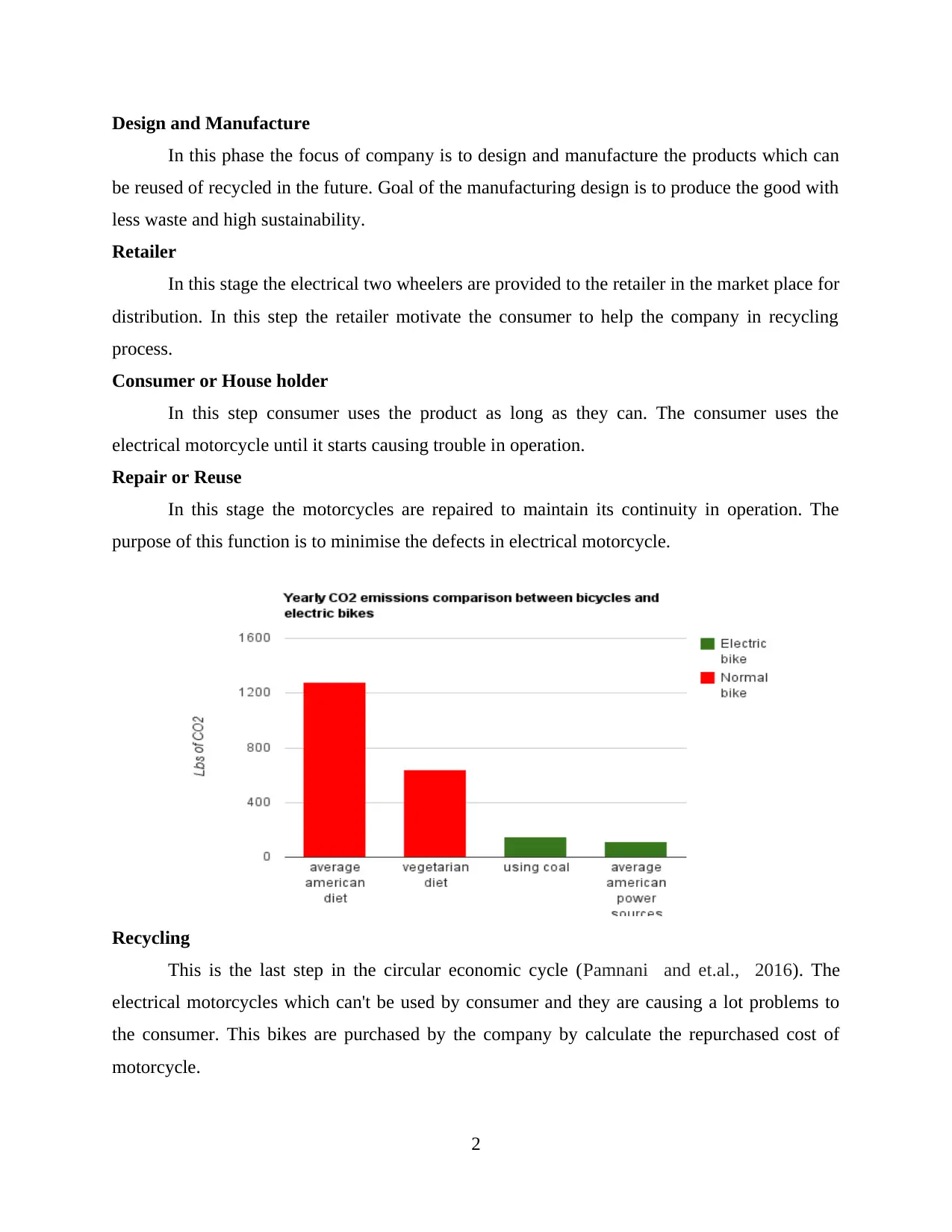
Design and Manufacture
In this phase the focus of company is to design and manufacture the products which can
be reused of recycled in the future. Goal of the manufacturing design is to produce the good with
less waste and high sustainability.
Retailer
In this stage the electrical two wheelers are provided to the retailer in the market place for
distribution. In this step the retailer motivate the consumer to help the company in recycling
process.
Consumer or House holder
In this step consumer uses the product as long as they can. The consumer uses the
electrical motorcycle until it starts causing trouble in operation.
Repair or Reuse
In this stage the motorcycles are repaired to maintain its continuity in operation. The
purpose of this function is to minimise the defects in electrical motorcycle.
Recycling
This is the last step in the circular economic cycle (Pamnani and et.al., 2016). The
electrical motorcycles which can't be used by consumer and they are causing a lot problems to
the consumer. This bikes are purchased by the company by calculate the repurchased cost of
motorcycle.
2
In this phase the focus of company is to design and manufacture the products which can
be reused of recycled in the future. Goal of the manufacturing design is to produce the good with
less waste and high sustainability.
Retailer
In this stage the electrical two wheelers are provided to the retailer in the market place for
distribution. In this step the retailer motivate the consumer to help the company in recycling
process.
Consumer or House holder
In this step consumer uses the product as long as they can. The consumer uses the
electrical motorcycle until it starts causing trouble in operation.
Repair or Reuse
In this stage the motorcycles are repaired to maintain its continuity in operation. The
purpose of this function is to minimise the defects in electrical motorcycle.
Recycling
This is the last step in the circular economic cycle (Pamnani and et.al., 2016). The
electrical motorcycles which can't be used by consumer and they are causing a lot problems to
the consumer. This bikes are purchased by the company by calculate the repurchased cost of
motorcycle.
2
Secure Best Marks with AI Grader
Need help grading? Try our AI Grader for instant feedback on your assignments.
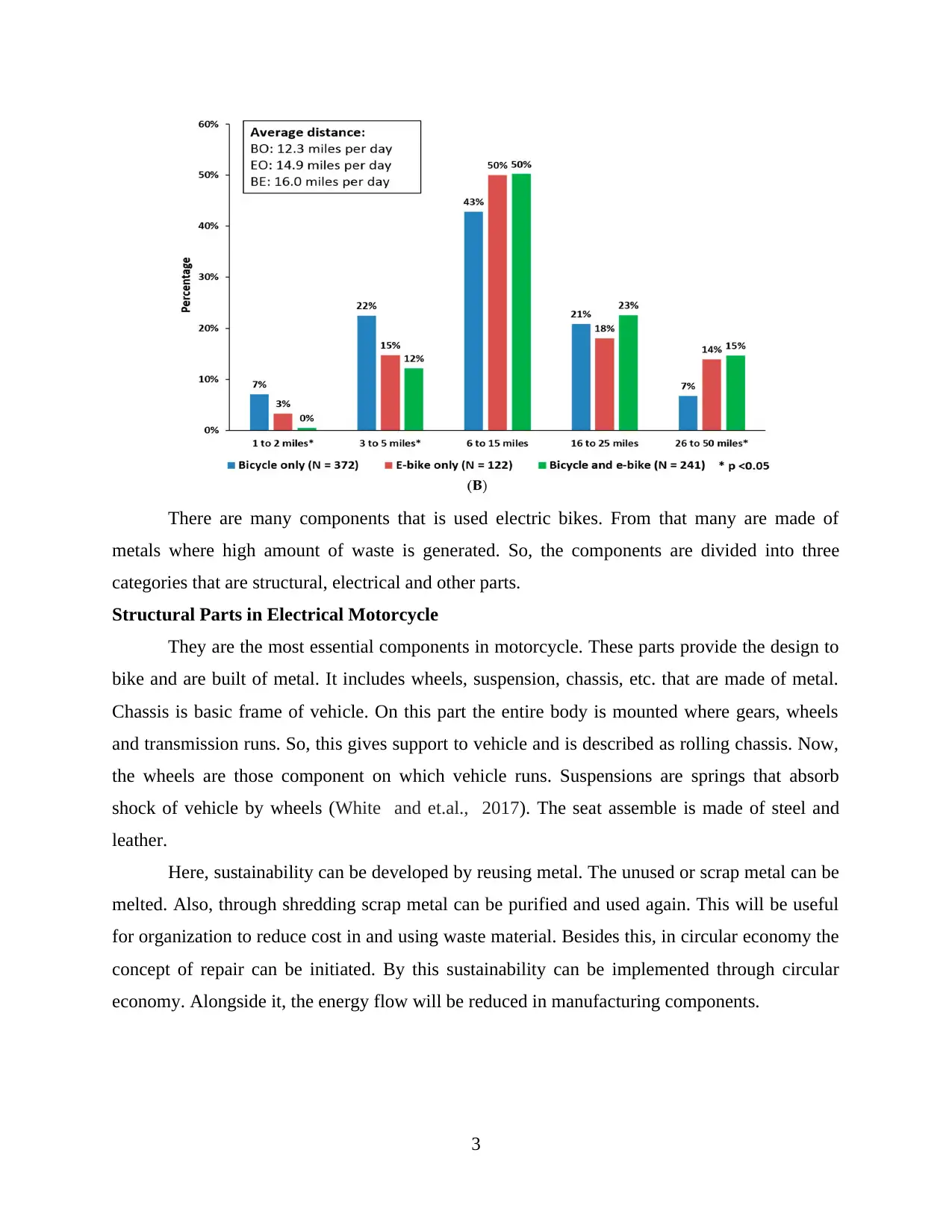
There are many components that is used electric bikes. From that many are made of
metals where high amount of waste is generated. So, the components are divided into three
categories that are structural, electrical and other parts.
Structural Parts in Electrical Motorcycle
They are the most essential components in motorcycle. These parts provide the design to
bike and are built of metal. It includes wheels, suspension, chassis, etc. that are made of metal.
Chassis is basic frame of vehicle. On this part the entire body is mounted where gears, wheels
and transmission runs. So, this gives support to vehicle and is described as rolling chassis. Now,
the wheels are those component on which vehicle runs. Suspensions are springs that absorb
shock of vehicle by wheels (White and et.al., 2017). The seat assemble is made of steel and
leather.
Here, sustainability can be developed by reusing metal. The unused or scrap metal can be
melted. Also, through shredding scrap metal can be purified and used again. This will be useful
for organization to reduce cost in and using waste material. Besides this, in circular economy the
concept of repair can be initiated. By this sustainability can be implemented through circular
economy. Alongside it, the energy flow will be reduced in manufacturing components.
3
metals where high amount of waste is generated. So, the components are divided into three
categories that are structural, electrical and other parts.
Structural Parts in Electrical Motorcycle
They are the most essential components in motorcycle. These parts provide the design to
bike and are built of metal. It includes wheels, suspension, chassis, etc. that are made of metal.
Chassis is basic frame of vehicle. On this part the entire body is mounted where gears, wheels
and transmission runs. So, this gives support to vehicle and is described as rolling chassis. Now,
the wheels are those component on which vehicle runs. Suspensions are springs that absorb
shock of vehicle by wheels (White and et.al., 2017). The seat assemble is made of steel and
leather.
Here, sustainability can be developed by reusing metal. The unused or scrap metal can be
melted. Also, through shredding scrap metal can be purified and used again. This will be useful
for organization to reduce cost in and using waste material. Besides this, in circular economy the
concept of repair can be initiated. By this sustainability can be implemented through circular
economy. Alongside it, the energy flow will be reduced in manufacturing components.
3
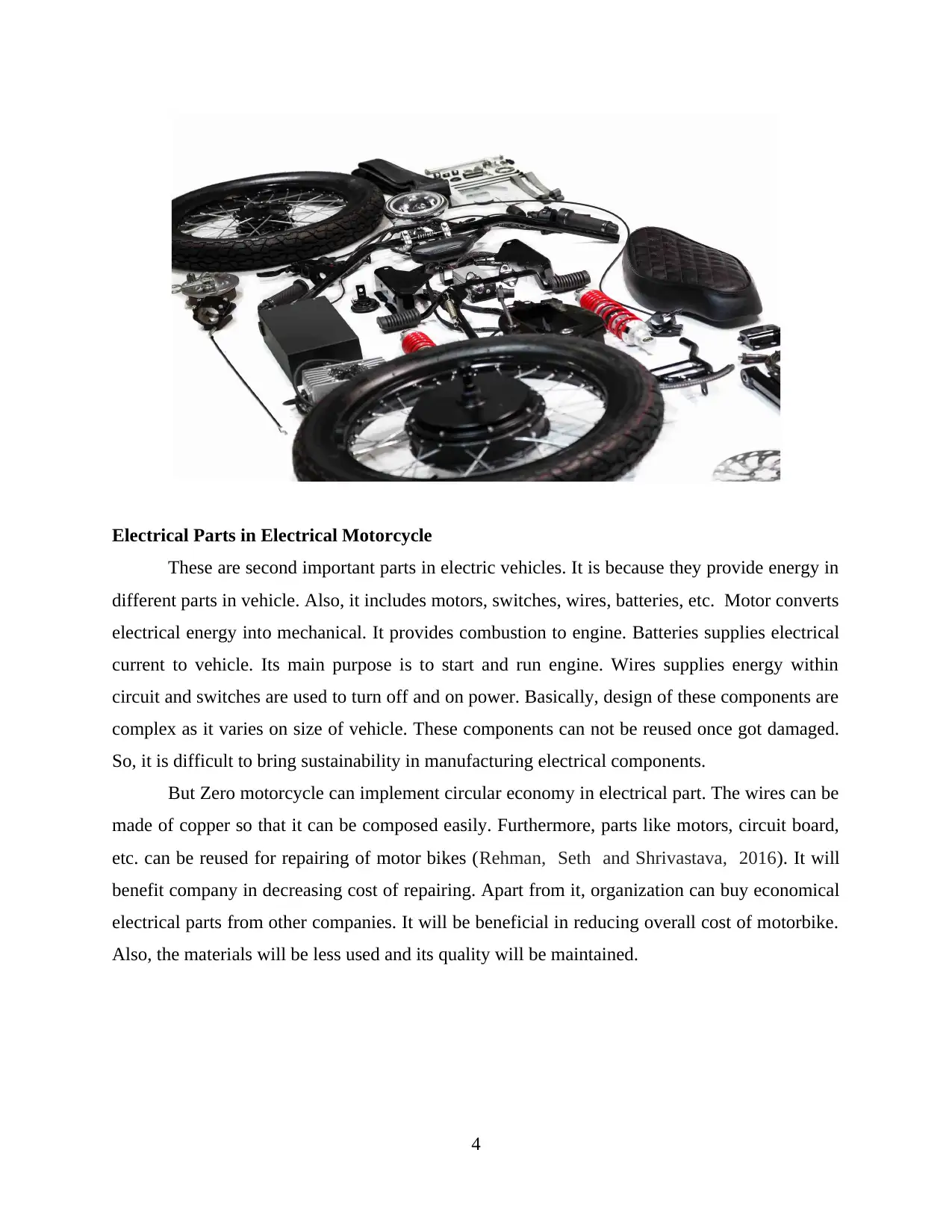
Electrical Parts in Electrical Motorcycle
These are second important parts in electric vehicles. It is because they provide energy in
different parts in vehicle. Also, it includes motors, switches, wires, batteries, etc. Motor converts
electrical energy into mechanical. It provides combustion to engine. Batteries supplies electrical
current to vehicle. Its main purpose is to start and run engine. Wires supplies energy within
circuit and switches are used to turn off and on power. Basically, design of these components are
complex as it varies on size of vehicle. These components can not be reused once got damaged.
So, it is difficult to bring sustainability in manufacturing electrical components.
But Zero motorcycle can implement circular economy in electrical part. The wires can be
made of copper so that it can be composed easily. Furthermore, parts like motors, circuit board,
etc. can be reused for repairing of motor bikes (Rehman, Seth and Shrivastava, 2016). It will
benefit company in decreasing cost of repairing. Apart from it, organization can buy economical
electrical parts from other companies. It will be beneficial in reducing overall cost of motorbike.
Also, the materials will be less used and its quality will be maintained.
4
These are second important parts in electric vehicles. It is because they provide energy in
different parts in vehicle. Also, it includes motors, switches, wires, batteries, etc. Motor converts
electrical energy into mechanical. It provides combustion to engine. Batteries supplies electrical
current to vehicle. Its main purpose is to start and run engine. Wires supplies energy within
circuit and switches are used to turn off and on power. Basically, design of these components are
complex as it varies on size of vehicle. These components can not be reused once got damaged.
So, it is difficult to bring sustainability in manufacturing electrical components.
But Zero motorcycle can implement circular economy in electrical part. The wires can be
made of copper so that it can be composed easily. Furthermore, parts like motors, circuit board,
etc. can be reused for repairing of motor bikes (Rehman, Seth and Shrivastava, 2016). It will
benefit company in decreasing cost of repairing. Apart from it, organization can buy economical
electrical parts from other companies. It will be beneficial in reducing overall cost of motorbike.
Also, the materials will be less used and its quality will be maintained.
4
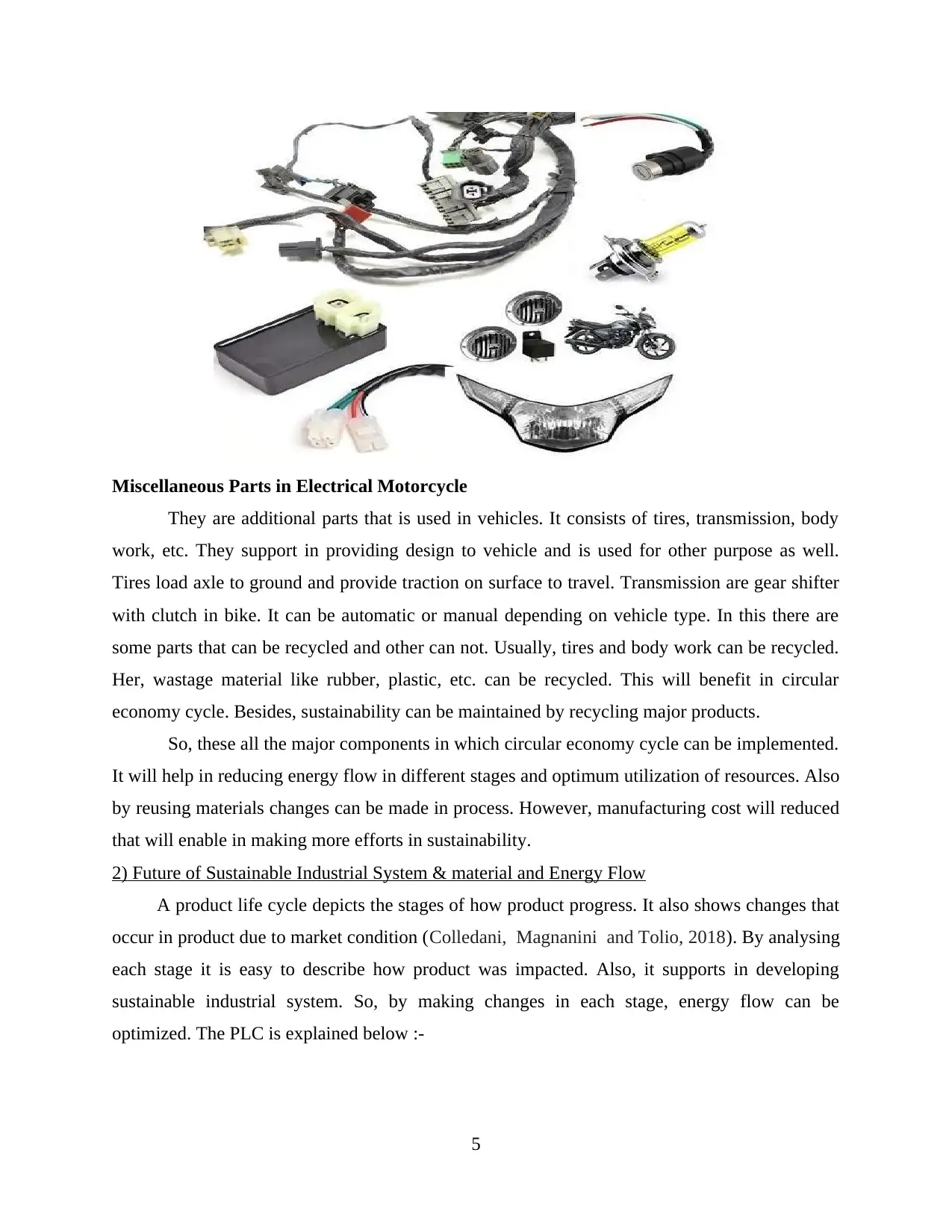
Miscellaneous Parts in Electrical Motorcycle
They are additional parts that is used in vehicles. It consists of tires, transmission, body
work, etc. They support in providing design to vehicle and is used for other purpose as well.
Tires load axle to ground and provide traction on surface to travel. Transmission are gear shifter
with clutch in bike. It can be automatic or manual depending on vehicle type. In this there are
some parts that can be recycled and other can not. Usually, tires and body work can be recycled.
Her, wastage material like rubber, plastic, etc. can be recycled. This will benefit in circular
economy cycle. Besides, sustainability can be maintained by recycling major products.
So, these all the major components in which circular economy cycle can be implemented.
It will help in reducing energy flow in different stages and optimum utilization of resources. Also
by reusing materials changes can be made in process. However, manufacturing cost will reduced
that will enable in making more efforts in sustainability.
2) Future of Sustainable Industrial System & material and Energy Flow
A product life cycle depicts the stages of how product progress. It also shows changes that
occur in product due to market condition (Colledani, Magnanini and Tolio, 2018). By analysing
each stage it is easy to describe how product was impacted. Also, it supports in developing
sustainable industrial system. So, by making changes in each stage, energy flow can be
optimized. The PLC is explained below :-
5
They are additional parts that is used in vehicles. It consists of tires, transmission, body
work, etc. They support in providing design to vehicle and is used for other purpose as well.
Tires load axle to ground and provide traction on surface to travel. Transmission are gear shifter
with clutch in bike. It can be automatic or manual depending on vehicle type. In this there are
some parts that can be recycled and other can not. Usually, tires and body work can be recycled.
Her, wastage material like rubber, plastic, etc. can be recycled. This will benefit in circular
economy cycle. Besides, sustainability can be maintained by recycling major products.
So, these all the major components in which circular economy cycle can be implemented.
It will help in reducing energy flow in different stages and optimum utilization of resources. Also
by reusing materials changes can be made in process. However, manufacturing cost will reduced
that will enable in making more efforts in sustainability.
2) Future of Sustainable Industrial System & material and Energy Flow
A product life cycle depicts the stages of how product progress. It also shows changes that
occur in product due to market condition (Colledani, Magnanini and Tolio, 2018). By analysing
each stage it is easy to describe how product was impacted. Also, it supports in developing
sustainable industrial system. So, by making changes in each stage, energy flow can be
optimized. The PLC is explained below :-
5
Paraphrase This Document
Need a fresh take? Get an instant paraphrase of this document with our AI Paraphraser
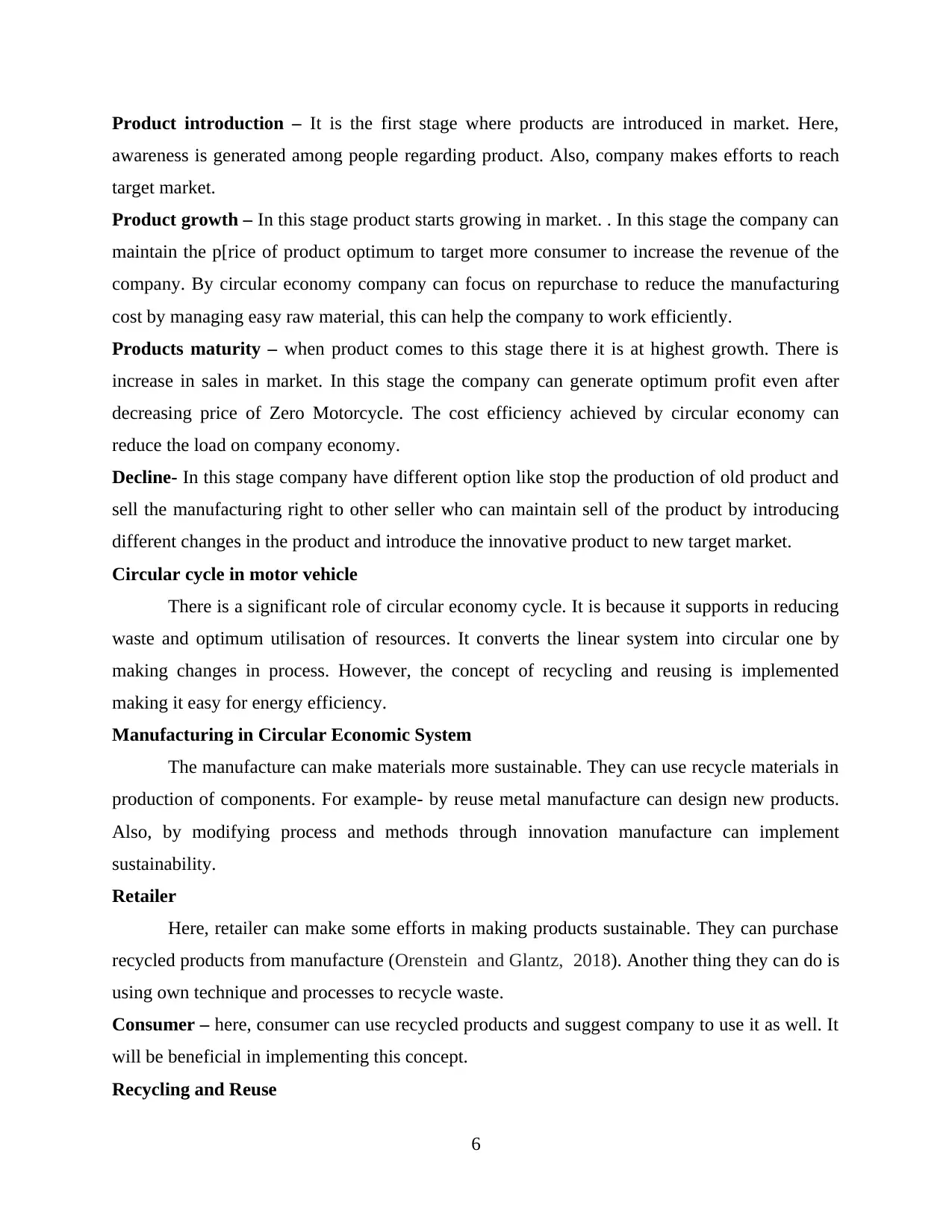
Product introduction – It is the first stage where products are introduced in market. Here,
awareness is generated among people regarding product. Also, company makes efforts to reach
target market.
Product growth – In this stage product starts growing in market. . In this stage the company can
maintain the p[rice of product optimum to target more consumer to increase the revenue of the
company. By circular economy company can focus on repurchase to reduce the manufacturing
cost by managing easy raw material, this can help the company to work efficiently.
Products maturity – when product comes to this stage there it is at highest growth. There is
increase in sales in market. In this stage the company can generate optimum profit even after
decreasing price of Zero Motorcycle. The cost efficiency achieved by circular economy can
reduce the load on company economy.
Decline- In this stage company have different option like stop the production of old product and
sell the manufacturing right to other seller who can maintain sell of the product by introducing
different changes in the product and introduce the innovative product to new target market.
Circular cycle in motor vehicle
There is a significant role of circular economy cycle. It is because it supports in reducing
waste and optimum utilisation of resources. It converts the linear system into circular one by
making changes in process. However, the concept of recycling and reusing is implemented
making it easy for energy efficiency.
Manufacturing in Circular Economic System
The manufacture can make materials more sustainable. They can use recycle materials in
production of components. For example- by reuse metal manufacture can design new products.
Also, by modifying process and methods through innovation manufacture can implement
sustainability.
Retailer
Here, retailer can make some efforts in making products sustainable. They can purchase
recycled products from manufacture (Orenstein and Glantz, 2018). Another thing they can do is
using own technique and processes to recycle waste.
Consumer – here, consumer can use recycled products and suggest company to use it as well. It
will be beneficial in implementing this concept.
Recycling and Reuse
6
awareness is generated among people regarding product. Also, company makes efforts to reach
target market.
Product growth – In this stage product starts growing in market. . In this stage the company can
maintain the p[rice of product optimum to target more consumer to increase the revenue of the
company. By circular economy company can focus on repurchase to reduce the manufacturing
cost by managing easy raw material, this can help the company to work efficiently.
Products maturity – when product comes to this stage there it is at highest growth. There is
increase in sales in market. In this stage the company can generate optimum profit even after
decreasing price of Zero Motorcycle. The cost efficiency achieved by circular economy can
reduce the load on company economy.
Decline- In this stage company have different option like stop the production of old product and
sell the manufacturing right to other seller who can maintain sell of the product by introducing
different changes in the product and introduce the innovative product to new target market.
Circular cycle in motor vehicle
There is a significant role of circular economy cycle. It is because it supports in reducing
waste and optimum utilisation of resources. It converts the linear system into circular one by
making changes in process. However, the concept of recycling and reusing is implemented
making it easy for energy efficiency.
Manufacturing in Circular Economic System
The manufacture can make materials more sustainable. They can use recycle materials in
production of components. For example- by reuse metal manufacture can design new products.
Also, by modifying process and methods through innovation manufacture can implement
sustainability.
Retailer
Here, retailer can make some efforts in making products sustainable. They can purchase
recycled products from manufacture (Orenstein and Glantz, 2018). Another thing they can do is
using own technique and processes to recycle waste.
Consumer – here, consumer can use recycled products and suggest company to use it as well. It
will be beneficial in implementing this concept.
Recycling and Reuse
6
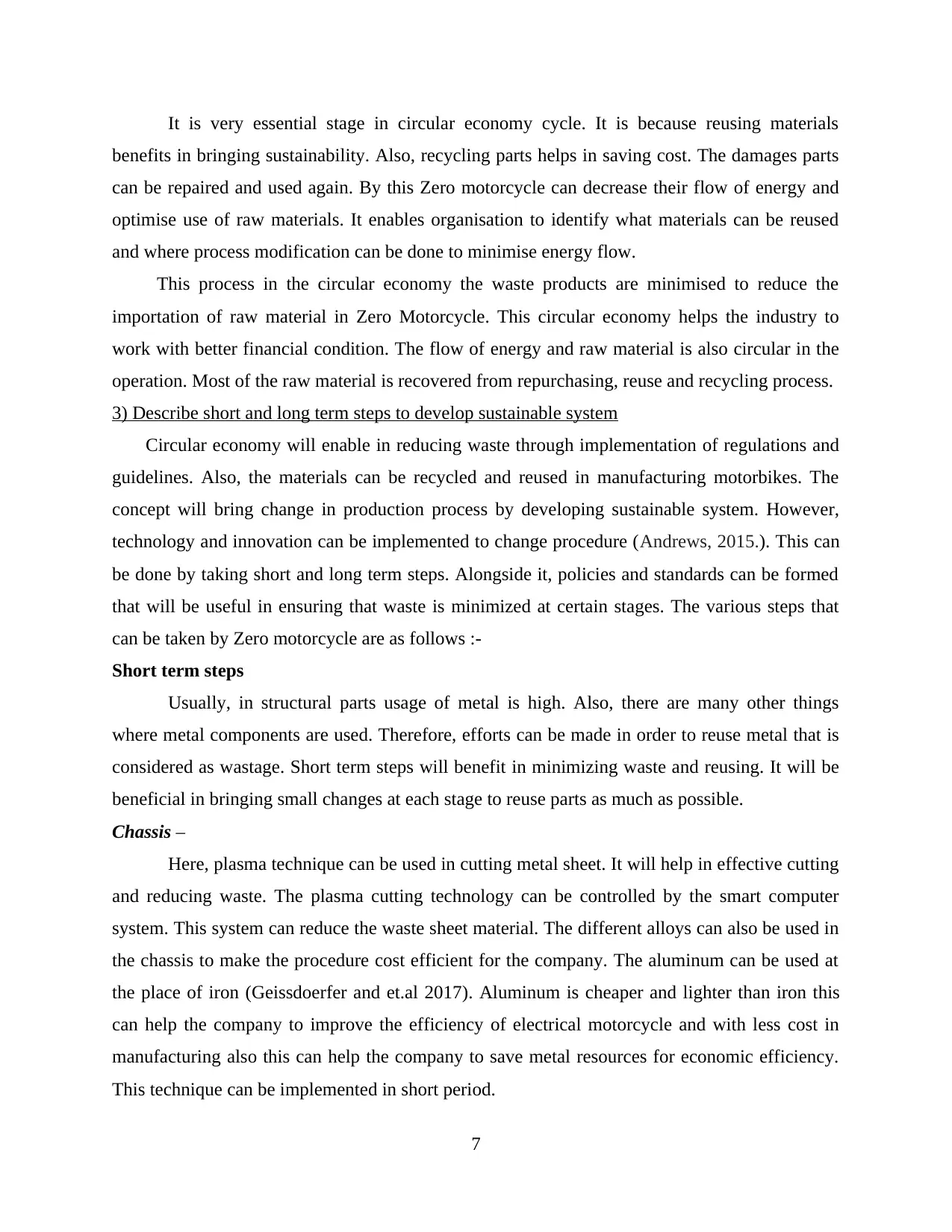
It is very essential stage in circular economy cycle. It is because reusing materials
benefits in bringing sustainability. Also, recycling parts helps in saving cost. The damages parts
can be repaired and used again. By this Zero motorcycle can decrease their flow of energy and
optimise use of raw materials. It enables organisation to identify what materials can be reused
and where process modification can be done to minimise energy flow.
This process in the circular economy the waste products are minimised to reduce the
importation of raw material in Zero Motorcycle. This circular economy helps the industry to
work with better financial condition. The flow of energy and raw material is also circular in the
operation. Most of the raw material is recovered from repurchasing, reuse and recycling process.
3) Describe short and long term steps to develop sustainable system
Circular economy will enable in reducing waste through implementation of regulations and
guidelines. Also, the materials can be recycled and reused in manufacturing motorbikes. The
concept will bring change in production process by developing sustainable system. However,
technology and innovation can be implemented to change procedure (Andrews, 2015.). This can
be done by taking short and long term steps. Alongside it, policies and standards can be formed
that will be useful in ensuring that waste is minimized at certain stages. The various steps that
can be taken by Zero motorcycle are as follows :-
Short term steps
Usually, in structural parts usage of metal is high. Also, there are many other things
where metal components are used. Therefore, efforts can be made in order to reuse metal that is
considered as wastage. Short term steps will benefit in minimizing waste and reusing. It will be
beneficial in bringing small changes at each stage to reuse parts as much as possible.
Chassis –
Here, plasma technique can be used in cutting metal sheet. It will help in effective cutting
and reducing waste. The plasma cutting technology can be controlled by the smart computer
system. This system can reduce the waste sheet material. The different alloys can also be used in
the chassis to make the procedure cost efficient for the company. The aluminum can be used at
the place of iron (Geissdoerfer and et.al 2017). Aluminum is cheaper and lighter than iron this
can help the company to improve the efficiency of electrical motorcycle and with less cost in
manufacturing also this can help the company to save metal resources for economic efficiency.
This technique can be implemented in short period.
7
benefits in bringing sustainability. Also, recycling parts helps in saving cost. The damages parts
can be repaired and used again. By this Zero motorcycle can decrease their flow of energy and
optimise use of raw materials. It enables organisation to identify what materials can be reused
and where process modification can be done to minimise energy flow.
This process in the circular economy the waste products are minimised to reduce the
importation of raw material in Zero Motorcycle. This circular economy helps the industry to
work with better financial condition. The flow of energy and raw material is also circular in the
operation. Most of the raw material is recovered from repurchasing, reuse and recycling process.
3) Describe short and long term steps to develop sustainable system
Circular economy will enable in reducing waste through implementation of regulations and
guidelines. Also, the materials can be recycled and reused in manufacturing motorbikes. The
concept will bring change in production process by developing sustainable system. However,
technology and innovation can be implemented to change procedure (Andrews, 2015.). This can
be done by taking short and long term steps. Alongside it, policies and standards can be formed
that will be useful in ensuring that waste is minimized at certain stages. The various steps that
can be taken by Zero motorcycle are as follows :-
Short term steps
Usually, in structural parts usage of metal is high. Also, there are many other things
where metal components are used. Therefore, efforts can be made in order to reuse metal that is
considered as wastage. Short term steps will benefit in minimizing waste and reusing. It will be
beneficial in bringing small changes at each stage to reuse parts as much as possible.
Chassis –
Here, plasma technique can be used in cutting metal sheet. It will help in effective cutting
and reducing waste. The plasma cutting technology can be controlled by the smart computer
system. This system can reduce the waste sheet material. The different alloys can also be used in
the chassis to make the procedure cost efficient for the company. The aluminum can be used at
the place of iron (Geissdoerfer and et.al 2017). Aluminum is cheaper and lighter than iron this
can help the company to improve the efficiency of electrical motorcycle and with less cost in
manufacturing also this can help the company to save metal resources for economic efficiency.
This technique can be implemented in short period.
7
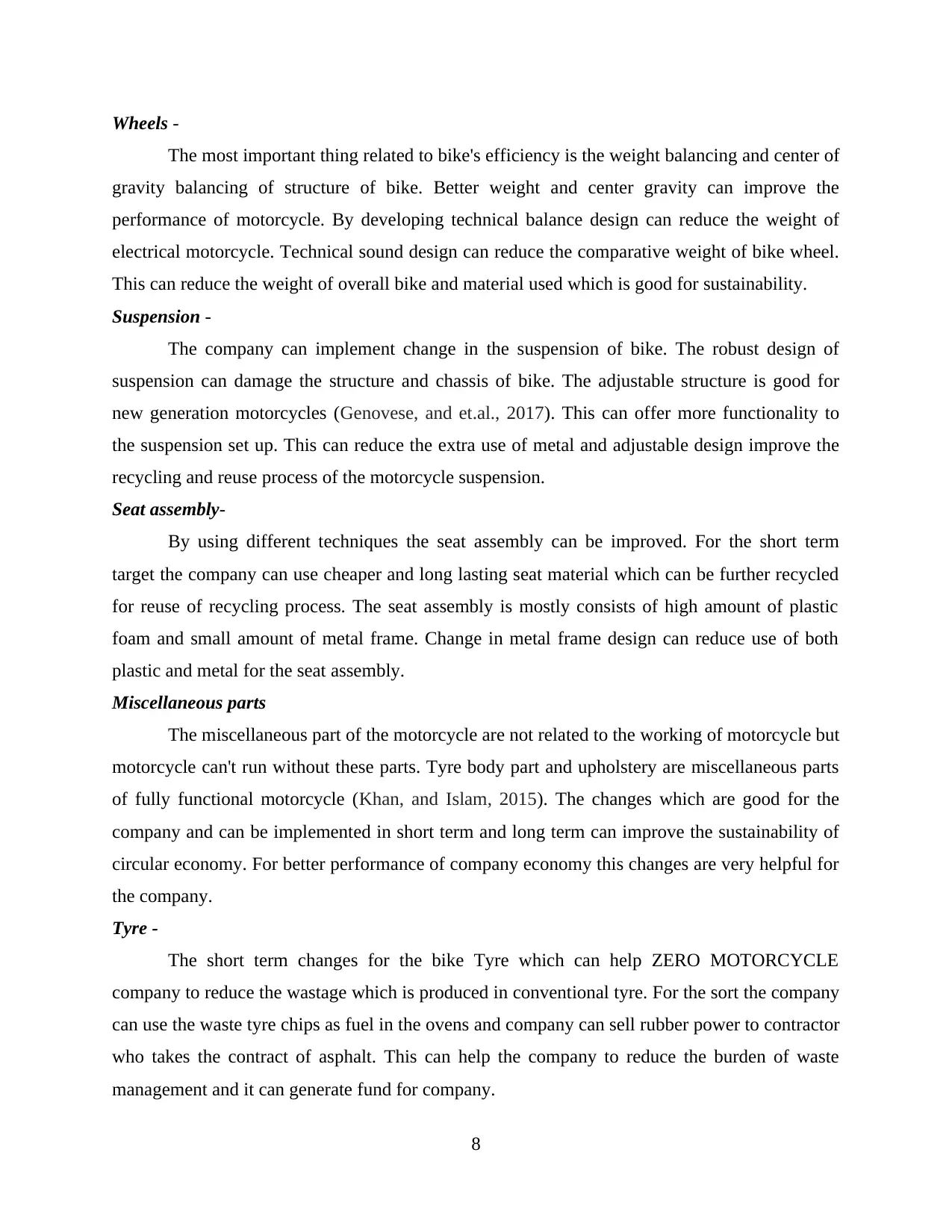
Wheels -
The most important thing related to bike's efficiency is the weight balancing and center of
gravity balancing of structure of bike. Better weight and center gravity can improve the
performance of motorcycle. By developing technical balance design can reduce the weight of
electrical motorcycle. Technical sound design can reduce the comparative weight of bike wheel.
This can reduce the weight of overall bike and material used which is good for sustainability.
Suspension -
The company can implement change in the suspension of bike. The robust design of
suspension can damage the structure and chassis of bike. The adjustable structure is good for
new generation motorcycles (Genovese, and et.al., 2017). This can offer more functionality to
the suspension set up. This can reduce the extra use of metal and adjustable design improve the
recycling and reuse process of the motorcycle suspension.
Seat assembly-
By using different techniques the seat assembly can be improved. For the short term
target the company can use cheaper and long lasting seat material which can be further recycled
for reuse of recycling process. The seat assembly is mostly consists of high amount of plastic
foam and small amount of metal frame. Change in metal frame design can reduce use of both
plastic and metal for the seat assembly.
Miscellaneous parts
The miscellaneous part of the motorcycle are not related to the working of motorcycle but
motorcycle can't run without these parts. Tyre body part and upholstery are miscellaneous parts
of fully functional motorcycle (Khan, and Islam, 2015). The changes which are good for the
company and can be implemented in short term and long term can improve the sustainability of
circular economy. For better performance of company economy this changes are very helpful for
the company.
Tyre -
The short term changes for the bike Tyre which can help ZERO MOTORCYCLE
company to reduce the wastage which is produced in conventional tyre. For the sort the company
can use the waste tyre chips as fuel in the ovens and company can sell rubber power to contractor
who takes the contract of asphalt. This can help the company to reduce the burden of waste
management and it can generate fund for company.
8
The most important thing related to bike's efficiency is the weight balancing and center of
gravity balancing of structure of bike. Better weight and center gravity can improve the
performance of motorcycle. By developing technical balance design can reduce the weight of
electrical motorcycle. Technical sound design can reduce the comparative weight of bike wheel.
This can reduce the weight of overall bike and material used which is good for sustainability.
Suspension -
The company can implement change in the suspension of bike. The robust design of
suspension can damage the structure and chassis of bike. The adjustable structure is good for
new generation motorcycles (Genovese, and et.al., 2017). This can offer more functionality to
the suspension set up. This can reduce the extra use of metal and adjustable design improve the
recycling and reuse process of the motorcycle suspension.
Seat assembly-
By using different techniques the seat assembly can be improved. For the short term
target the company can use cheaper and long lasting seat material which can be further recycled
for reuse of recycling process. The seat assembly is mostly consists of high amount of plastic
foam and small amount of metal frame. Change in metal frame design can reduce use of both
plastic and metal for the seat assembly.
Miscellaneous parts
The miscellaneous part of the motorcycle are not related to the working of motorcycle but
motorcycle can't run without these parts. Tyre body part and upholstery are miscellaneous parts
of fully functional motorcycle (Khan, and Islam, 2015). The changes which are good for the
company and can be implemented in short term and long term can improve the sustainability of
circular economy. For better performance of company economy this changes are very helpful for
the company.
Tyre -
The short term changes for the bike Tyre which can help ZERO MOTORCYCLE
company to reduce the wastage which is produced in conventional tyre. For the sort the company
can use the waste tyre chips as fuel in the ovens and company can sell rubber power to contractor
who takes the contract of asphalt. This can help the company to reduce the burden of waste
management and it can generate fund for company.
8
Secure Best Marks with AI Grader
Need help grading? Try our AI Grader for instant feedback on your assignments.
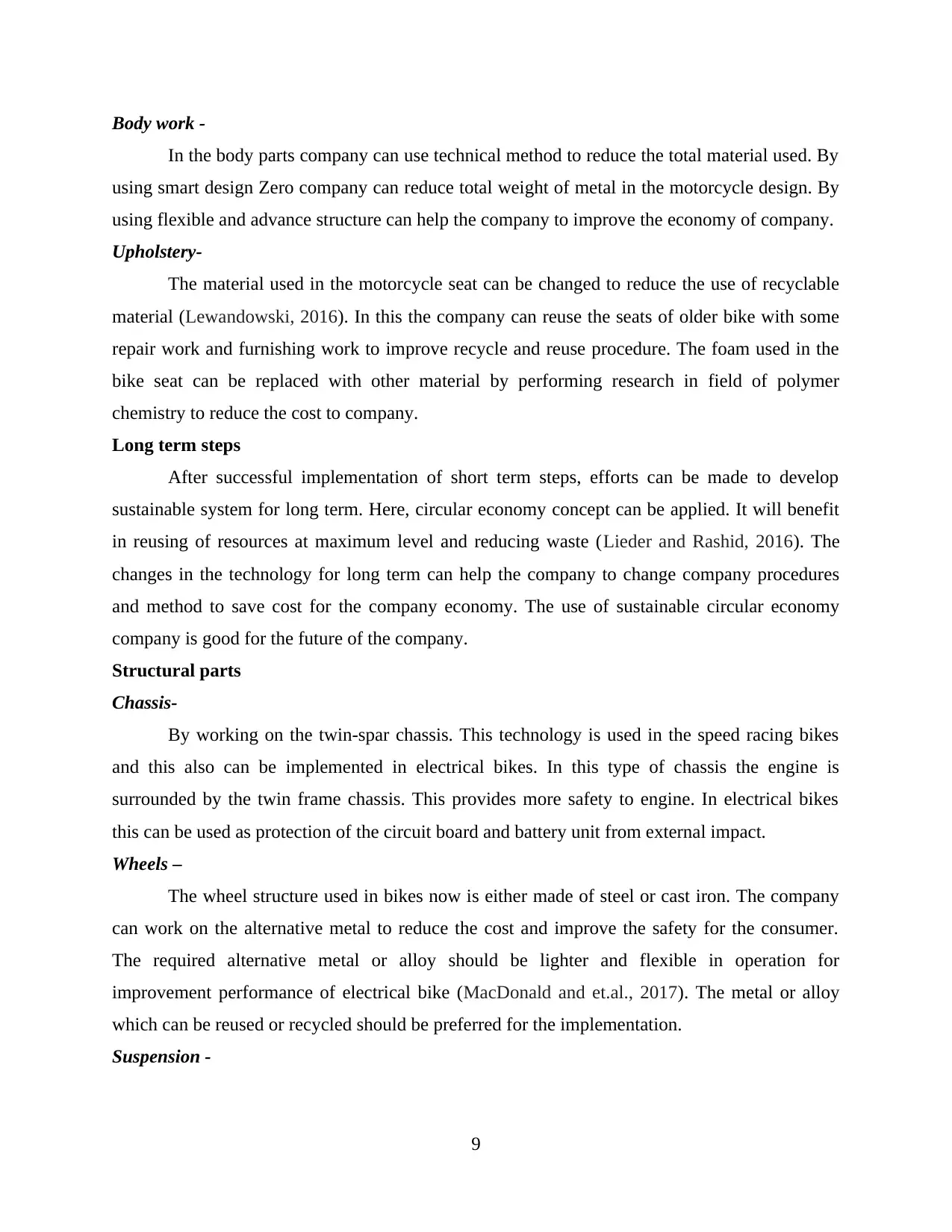
Body work -
In the body parts company can use technical method to reduce the total material used. By
using smart design Zero company can reduce total weight of metal in the motorcycle design. By
using flexible and advance structure can help the company to improve the economy of company.
Upholstery-
The material used in the motorcycle seat can be changed to reduce the use of recyclable
material (Lewandowski, 2016). In this the company can reuse the seats of older bike with some
repair work and furnishing work to improve recycle and reuse procedure. The foam used in the
bike seat can be replaced with other material by performing research in field of polymer
chemistry to reduce the cost to company.
Long term steps
After successful implementation of short term steps, efforts can be made to develop
sustainable system for long term. Here, circular economy concept can be applied. It will benefit
in reusing of resources at maximum level and reducing waste (Lieder and Rashid, 2016). The
changes in the technology for long term can help the company to change company procedures
and method to save cost for the company economy. The use of sustainable circular economy
company is good for the future of the company.
Structural parts
Chassis-
By working on the twin-spar chassis. This technology is used in the speed racing bikes
and this also can be implemented in electrical bikes. In this type of chassis the engine is
surrounded by the twin frame chassis. This provides more safety to engine. In electrical bikes
this can be used as protection of the circuit board and battery unit from external impact.
Wheels –
The wheel structure used in bikes now is either made of steel or cast iron. The company
can work on the alternative metal to reduce the cost and improve the safety for the consumer.
The required alternative metal or alloy should be lighter and flexible in operation for
improvement performance of electrical bike (MacDonald and et.al., 2017). The metal or alloy
which can be reused or recycled should be preferred for the implementation.
Suspension -
9
In the body parts company can use technical method to reduce the total material used. By
using smart design Zero company can reduce total weight of metal in the motorcycle design. By
using flexible and advance structure can help the company to improve the economy of company.
Upholstery-
The material used in the motorcycle seat can be changed to reduce the use of recyclable
material (Lewandowski, 2016). In this the company can reuse the seats of older bike with some
repair work and furnishing work to improve recycle and reuse procedure. The foam used in the
bike seat can be replaced with other material by performing research in field of polymer
chemistry to reduce the cost to company.
Long term steps
After successful implementation of short term steps, efforts can be made to develop
sustainable system for long term. Here, circular economy concept can be applied. It will benefit
in reusing of resources at maximum level and reducing waste (Lieder and Rashid, 2016). The
changes in the technology for long term can help the company to change company procedures
and method to save cost for the company economy. The use of sustainable circular economy
company is good for the future of the company.
Structural parts
Chassis-
By working on the twin-spar chassis. This technology is used in the speed racing bikes
and this also can be implemented in electrical bikes. In this type of chassis the engine is
surrounded by the twin frame chassis. This provides more safety to engine. In electrical bikes
this can be used as protection of the circuit board and battery unit from external impact.
Wheels –
The wheel structure used in bikes now is either made of steel or cast iron. The company
can work on the alternative metal to reduce the cost and improve the safety for the consumer.
The required alternative metal or alloy should be lighter and flexible in operation for
improvement performance of electrical bike (MacDonald and et.al., 2017). The metal or alloy
which can be reused or recycled should be preferred for the implementation.
Suspension -
9
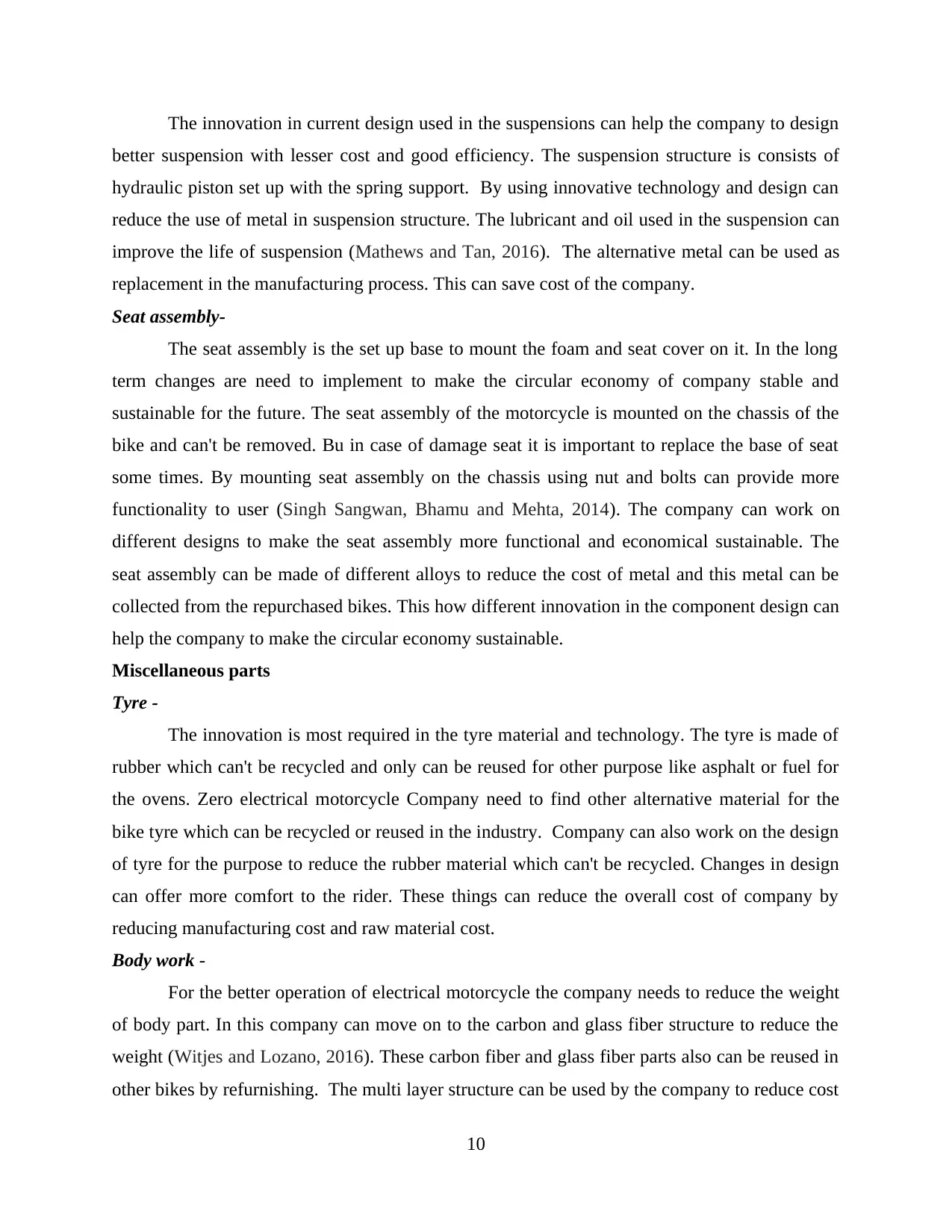
The innovation in current design used in the suspensions can help the company to design
better suspension with lesser cost and good efficiency. The suspension structure is consists of
hydraulic piston set up with the spring support. By using innovative technology and design can
reduce the use of metal in suspension structure. The lubricant and oil used in the suspension can
improve the life of suspension (Mathews and Tan, 2016). The alternative metal can be used as
replacement in the manufacturing process. This can save cost of the company.
Seat assembly-
The seat assembly is the set up base to mount the foam and seat cover on it. In the long
term changes are need to implement to make the circular economy of company stable and
sustainable for the future. The seat assembly of the motorcycle is mounted on the chassis of the
bike and can't be removed. Bu in case of damage seat it is important to replace the base of seat
some times. By mounting seat assembly on the chassis using nut and bolts can provide more
functionality to user (Singh Sangwan, Bhamu and Mehta, 2014). The company can work on
different designs to make the seat assembly more functional and economical sustainable. The
seat assembly can be made of different alloys to reduce the cost of metal and this metal can be
collected from the repurchased bikes. This how different innovation in the component design can
help the company to make the circular economy sustainable.
Miscellaneous parts
Tyre -
The innovation is most required in the tyre material and technology. The tyre is made of
rubber which can't be recycled and only can be reused for other purpose like asphalt or fuel for
the ovens. Zero electrical motorcycle Company need to find other alternative material for the
bike tyre which can be recycled or reused in the industry. Company can also work on the design
of tyre for the purpose to reduce the rubber material which can't be recycled. Changes in design
can offer more comfort to the rider. These things can reduce the overall cost of company by
reducing manufacturing cost and raw material cost.
Body work -
For the better operation of electrical motorcycle the company needs to reduce the weight
of body part. In this company can move on to the carbon and glass fiber structure to reduce the
weight (Witjes and Lozano, 2016). These carbon fiber and glass fiber parts also can be reused in
other bikes by refurnishing. The multi layer structure can be used by the company to reduce cost
10
better suspension with lesser cost and good efficiency. The suspension structure is consists of
hydraulic piston set up with the spring support. By using innovative technology and design can
reduce the use of metal in suspension structure. The lubricant and oil used in the suspension can
improve the life of suspension (Mathews and Tan, 2016). The alternative metal can be used as
replacement in the manufacturing process. This can save cost of the company.
Seat assembly-
The seat assembly is the set up base to mount the foam and seat cover on it. In the long
term changes are need to implement to make the circular economy of company stable and
sustainable for the future. The seat assembly of the motorcycle is mounted on the chassis of the
bike and can't be removed. Bu in case of damage seat it is important to replace the base of seat
some times. By mounting seat assembly on the chassis using nut and bolts can provide more
functionality to user (Singh Sangwan, Bhamu and Mehta, 2014). The company can work on
different designs to make the seat assembly more functional and economical sustainable. The
seat assembly can be made of different alloys to reduce the cost of metal and this metal can be
collected from the repurchased bikes. This how different innovation in the component design can
help the company to make the circular economy sustainable.
Miscellaneous parts
Tyre -
The innovation is most required in the tyre material and technology. The tyre is made of
rubber which can't be recycled and only can be reused for other purpose like asphalt or fuel for
the ovens. Zero electrical motorcycle Company need to find other alternative material for the
bike tyre which can be recycled or reused in the industry. Company can also work on the design
of tyre for the purpose to reduce the rubber material which can't be recycled. Changes in design
can offer more comfort to the rider. These things can reduce the overall cost of company by
reducing manufacturing cost and raw material cost.
Body work -
For the better operation of electrical motorcycle the company needs to reduce the weight
of body part. In this company can move on to the carbon and glass fiber structure to reduce the
weight (Witjes and Lozano, 2016). These carbon fiber and glass fiber parts also can be reused in
other bikes by refurnishing. The multi layer structure can be used by the company to reduce cost
10
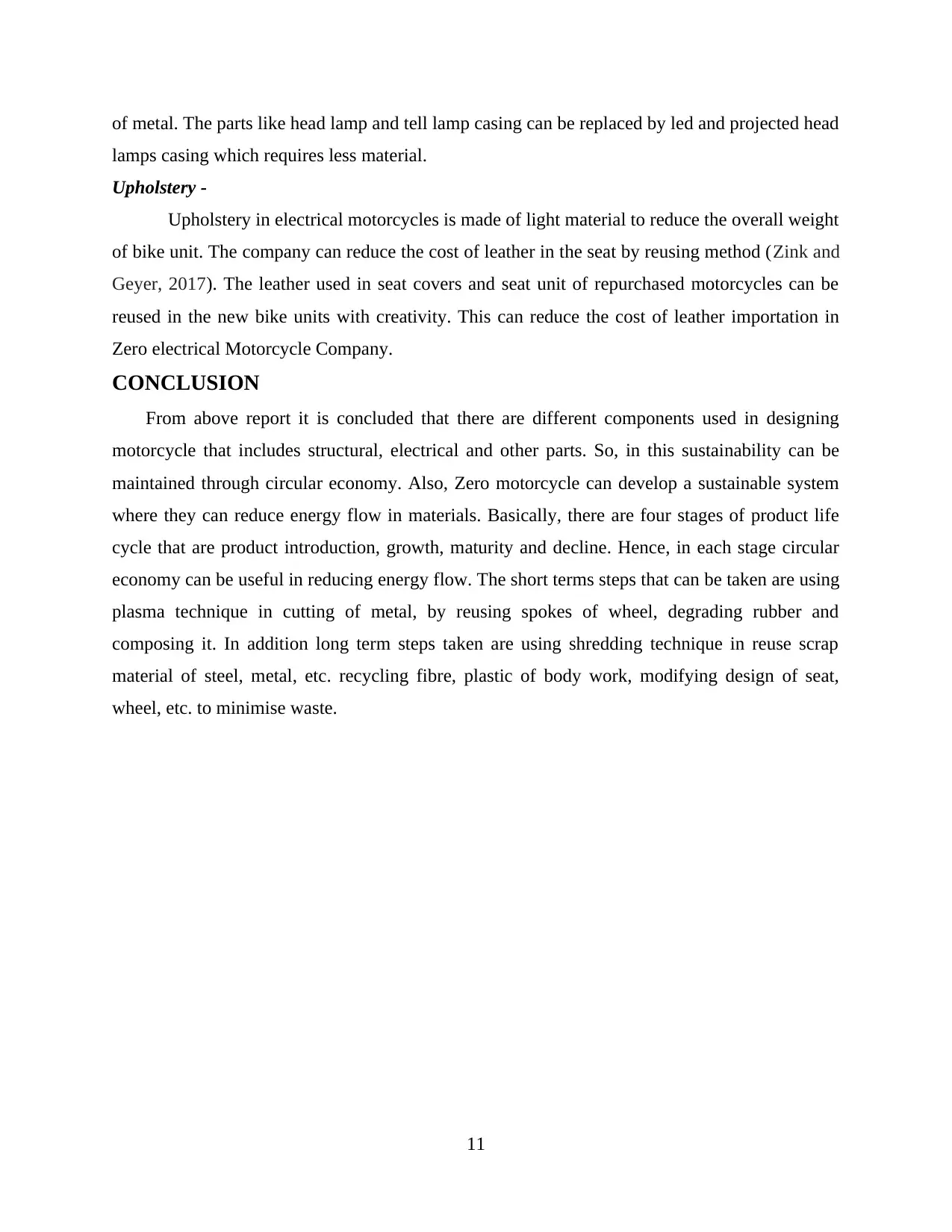
of metal. The parts like head lamp and tell lamp casing can be replaced by led and projected head
lamps casing which requires less material.
Upholstery -
Upholstery in electrical motorcycles is made of light material to reduce the overall weight
of bike unit. The company can reduce the cost of leather in the seat by reusing method (Zink and
Geyer, 2017). The leather used in seat covers and seat unit of repurchased motorcycles can be
reused in the new bike units with creativity. This can reduce the cost of leather importation in
Zero electrical Motorcycle Company.
CONCLUSION
From above report it is concluded that there are different components used in designing
motorcycle that includes structural, electrical and other parts. So, in this sustainability can be
maintained through circular economy. Also, Zero motorcycle can develop a sustainable system
where they can reduce energy flow in materials. Basically, there are four stages of product life
cycle that are product introduction, growth, maturity and decline. Hence, in each stage circular
economy can be useful in reducing energy flow. The short terms steps that can be taken are using
plasma technique in cutting of metal, by reusing spokes of wheel, degrading rubber and
composing it. In addition long term steps taken are using shredding technique in reuse scrap
material of steel, metal, etc. recycling fibre, plastic of body work, modifying design of seat,
wheel, etc. to minimise waste.
11
lamps casing which requires less material.
Upholstery -
Upholstery in electrical motorcycles is made of light material to reduce the overall weight
of bike unit. The company can reduce the cost of leather in the seat by reusing method (Zink and
Geyer, 2017). The leather used in seat covers and seat unit of repurchased motorcycles can be
reused in the new bike units with creativity. This can reduce the cost of leather importation in
Zero electrical Motorcycle Company.
CONCLUSION
From above report it is concluded that there are different components used in designing
motorcycle that includes structural, electrical and other parts. So, in this sustainability can be
maintained through circular economy. Also, Zero motorcycle can develop a sustainable system
where they can reduce energy flow in materials. Basically, there are four stages of product life
cycle that are product introduction, growth, maturity and decline. Hence, in each stage circular
economy can be useful in reducing energy flow. The short terms steps that can be taken are using
plasma technique in cutting of metal, by reusing spokes of wheel, degrading rubber and
composing it. In addition long term steps taken are using shredding technique in reuse scrap
material of steel, metal, etc. recycling fibre, plastic of body work, modifying design of seat,
wheel, etc. to minimise waste.
11
Paraphrase This Document
Need a fresh take? Get an instant paraphrase of this document with our AI Paraphraser
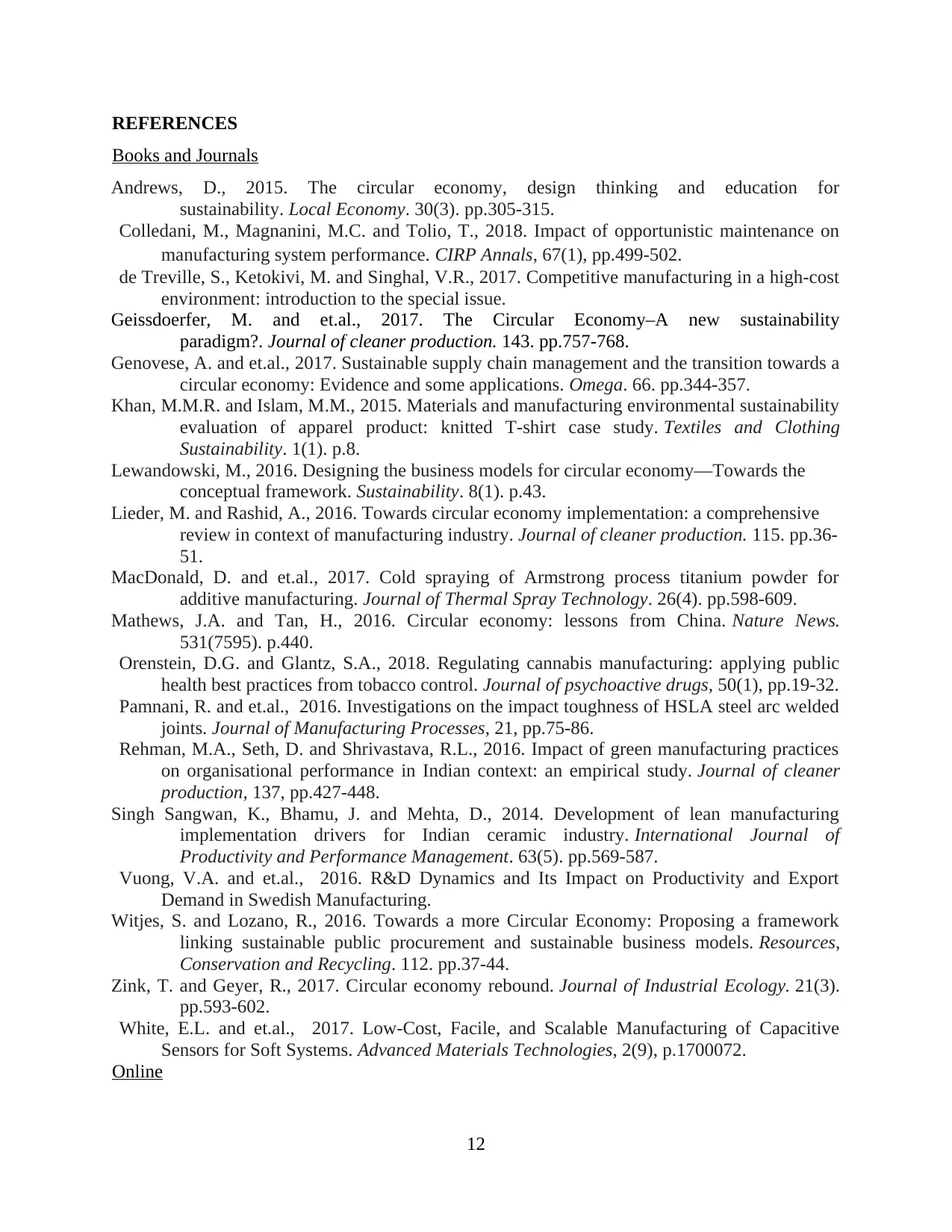
REFERENCES
Books and Journals
Andrews, D., 2015. The circular economy, design thinking and education for
sustainability. Local Economy. 30(3). pp.305-315.
Colledani, M., Magnanini, M.C. and Tolio, T., 2018. Impact of opportunistic maintenance on
manufacturing system performance. CIRP Annals, 67(1), pp.499-502.
de Treville, S., Ketokivi, M. and Singhal, V.R., 2017. Competitive manufacturing in a high-cost
environment: introduction to the special issue.
Geissdoerfer, M. and et.al., 2017. The Circular Economy–A new sustainability
paradigm?. Journal of cleaner production. 143. pp.757-768.
Genovese, A. and et.al., 2017. Sustainable supply chain management and the transition towards a
circular economy: Evidence and some applications. Omega. 66. pp.344-357.
Khan, M.M.R. and Islam, M.M., 2015. Materials and manufacturing environmental sustainability
evaluation of apparel product: knitted T-shirt case study. Textiles and Clothing
Sustainability. 1(1). p.8.
Lewandowski, M., 2016. Designing the business models for circular economy—Towards the
conceptual framework. Sustainability. 8(1). p.43.
Lieder, M. and Rashid, A., 2016. Towards circular economy implementation: a comprehensive
review in context of manufacturing industry. Journal of cleaner production. 115. pp.36-
51.
MacDonald, D. and et.al., 2017. Cold spraying of Armstrong process titanium powder for
additive manufacturing. Journal of Thermal Spray Technology. 26(4). pp.598-609.
Mathews, J.A. and Tan, H., 2016. Circular economy: lessons from China. Nature News.
531(7595). p.440.
Orenstein, D.G. and Glantz, S.A., 2018. Regulating cannabis manufacturing: applying public
health best practices from tobacco control. Journal of psychoactive drugs, 50(1), pp.19-32.
Pamnani, R. and et.al., 2016. Investigations on the impact toughness of HSLA steel arc welded
joints. Journal of Manufacturing Processes, 21, pp.75-86.
Rehman, M.A., Seth, D. and Shrivastava, R.L., 2016. Impact of green manufacturing practices
on organisational performance in Indian context: an empirical study. Journal of cleaner
production, 137, pp.427-448.
Singh Sangwan, K., Bhamu, J. and Mehta, D., 2014. Development of lean manufacturing
implementation drivers for Indian ceramic industry. International Journal of
Productivity and Performance Management. 63(5). pp.569-587.
Vuong, V.A. and et.al., 2016. R&D Dynamics and Its Impact on Productivity and Export
Demand in Swedish Manufacturing.
Witjes, S. and Lozano, R., 2016. Towards a more Circular Economy: Proposing a framework
linking sustainable public procurement and sustainable business models. Resources,
Conservation and Recycling. 112. pp.37-44.
Zink, T. and Geyer, R., 2017. Circular economy rebound. Journal of Industrial Ecology. 21(3).
pp.593-602.
White, E.L. and et.al., 2017. Low‐Cost, Facile, and Scalable Manufacturing of Capacitive
Sensors for Soft Systems. Advanced Materials Technologies, 2(9), p.1700072.
Online
12
Books and Journals
Andrews, D., 2015. The circular economy, design thinking and education for
sustainability. Local Economy. 30(3). pp.305-315.
Colledani, M., Magnanini, M.C. and Tolio, T., 2018. Impact of opportunistic maintenance on
manufacturing system performance. CIRP Annals, 67(1), pp.499-502.
de Treville, S., Ketokivi, M. and Singhal, V.R., 2017. Competitive manufacturing in a high-cost
environment: introduction to the special issue.
Geissdoerfer, M. and et.al., 2017. The Circular Economy–A new sustainability
paradigm?. Journal of cleaner production. 143. pp.757-768.
Genovese, A. and et.al., 2017. Sustainable supply chain management and the transition towards a
circular economy: Evidence and some applications. Omega. 66. pp.344-357.
Khan, M.M.R. and Islam, M.M., 2015. Materials and manufacturing environmental sustainability
evaluation of apparel product: knitted T-shirt case study. Textiles and Clothing
Sustainability. 1(1). p.8.
Lewandowski, M., 2016. Designing the business models for circular economy—Towards the
conceptual framework. Sustainability. 8(1). p.43.
Lieder, M. and Rashid, A., 2016. Towards circular economy implementation: a comprehensive
review in context of manufacturing industry. Journal of cleaner production. 115. pp.36-
51.
MacDonald, D. and et.al., 2017. Cold spraying of Armstrong process titanium powder for
additive manufacturing. Journal of Thermal Spray Technology. 26(4). pp.598-609.
Mathews, J.A. and Tan, H., 2016. Circular economy: lessons from China. Nature News.
531(7595). p.440.
Orenstein, D.G. and Glantz, S.A., 2018. Regulating cannabis manufacturing: applying public
health best practices from tobacco control. Journal of psychoactive drugs, 50(1), pp.19-32.
Pamnani, R. and et.al., 2016. Investigations on the impact toughness of HSLA steel arc welded
joints. Journal of Manufacturing Processes, 21, pp.75-86.
Rehman, M.A., Seth, D. and Shrivastava, R.L., 2016. Impact of green manufacturing practices
on organisational performance in Indian context: an empirical study. Journal of cleaner
production, 137, pp.427-448.
Singh Sangwan, K., Bhamu, J. and Mehta, D., 2014. Development of lean manufacturing
implementation drivers for Indian ceramic industry. International Journal of
Productivity and Performance Management. 63(5). pp.569-587.
Vuong, V.A. and et.al., 2016. R&D Dynamics and Its Impact on Productivity and Export
Demand in Swedish Manufacturing.
Witjes, S. and Lozano, R., 2016. Towards a more Circular Economy: Proposing a framework
linking sustainable public procurement and sustainable business models. Resources,
Conservation and Recycling. 112. pp.37-44.
Zink, T. and Geyer, R., 2017. Circular economy rebound. Journal of Industrial Ecology. 21(3).
pp.593-602.
White, E.L. and et.al., 2017. Low‐Cost, Facile, and Scalable Manufacturing of Capacitive
Sensors for Soft Systems. Advanced Materials Technologies, 2(9), p.1700072.
Online
12
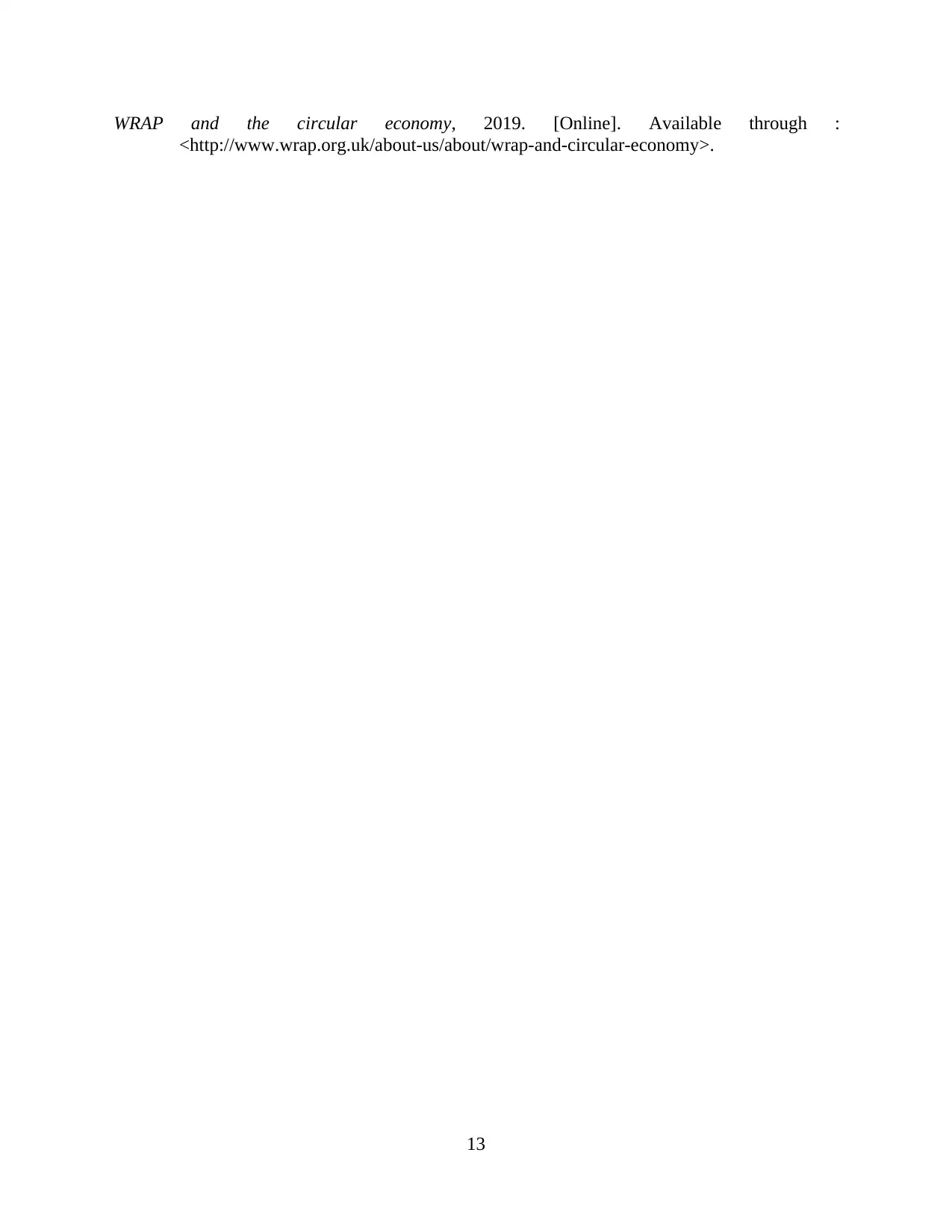
WRAP and the circular economy, 2019. [Online]. Available through :
<http://www.wrap.org.uk/about-us/about/wrap-and-circular-economy>.
13
<http://www.wrap.org.uk/about-us/about/wrap-and-circular-economy>.
13
1 out of 15
Related Documents
Your All-in-One AI-Powered Toolkit for Academic Success.
+13062052269
info@desklib.com
Available 24*7 on WhatsApp / Email
![[object Object]](/_next/static/media/star-bottom.7253800d.svg)
Unlock your academic potential
© 2024 | Zucol Services PVT LTD | All rights reserved.





